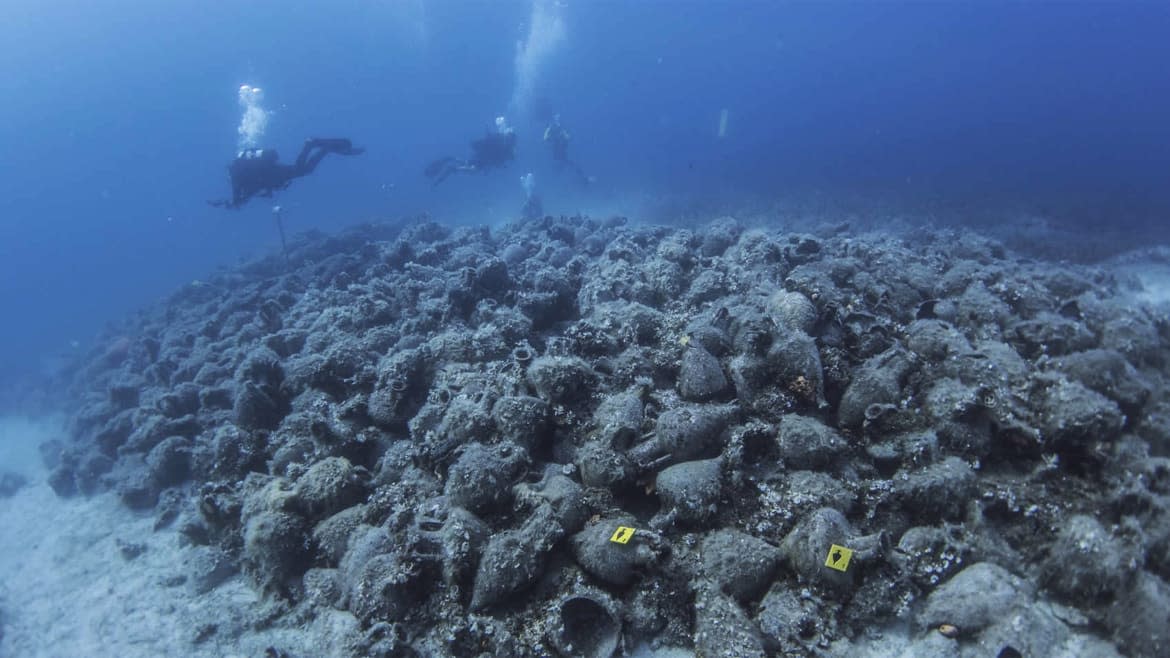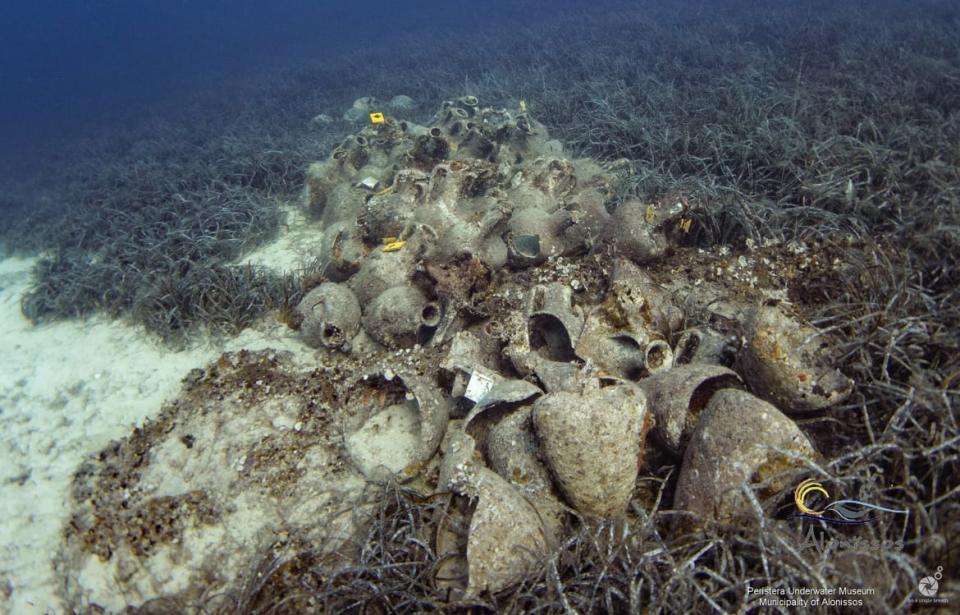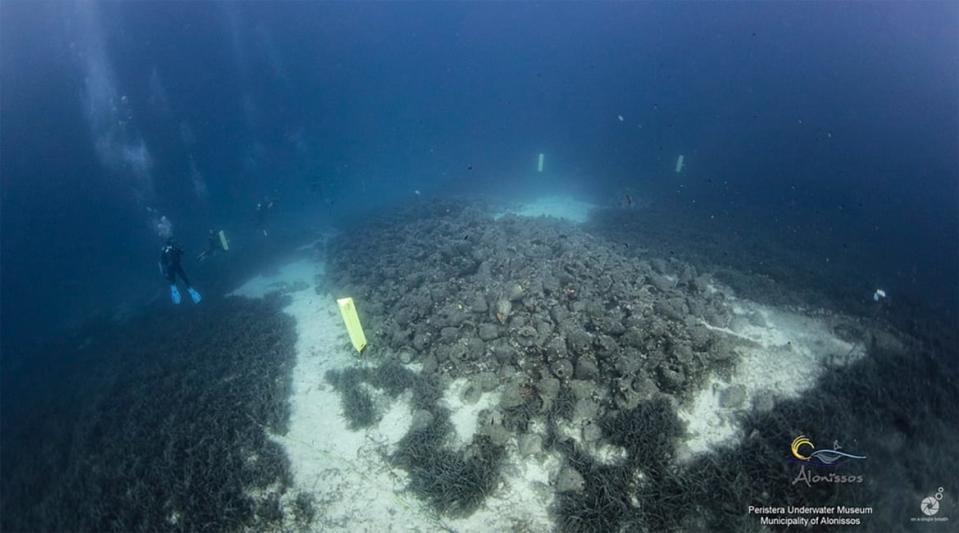Greece Thinks Its Future Is Underwater

In the early ’90s, off an island called Alonissos on Greece’s eastern coast, a fisherman chanced upon a wreck that would become known as “the Parthenon of shipwrecks.”
“As you go down and you see it from above and you see the volume of the wreck, it is truly spectacular,” said Panagiotis Anagnostou, diver and owner of Alonissos Seacolours. “It is about 25 meters long and 11 meters wide. It’s like stepping back in time—2,500 years ago.”
The Peristera shipwreck, its formal name, dates back to the late fifth century B.C. It is the very first underwater museum in Greece, and one of the most significant investments by the country in a market that is currently on the rise: underwater tourism. According to a recent report by the market research organization Future Market Insights, the global diving tourism market is estimated to reach $2.9 billion in 2022, a number expected to double in the next decade.
“People’s interest is now focused on this kind of tourism, either in what you see from the coasts or in the shipwrecks. I think this is because the equipment has been perfected and has become more affordable for anyone nowadays,” says Eleni Banou, the newly appointed director of Greece’s ephorate of underwater antiquities.
For Banou, an experienced archeologist with a Ph.D. from the University of Pennsylvania, this new position is just a new challenge. In 2016 Banou welcomed the then-president of the United States, Barack Obama, during his visit to Athens and showed him around the Acropolis as the director of the city’s Ephorate of Antiquities.
Now in her new role, she hopes to introduce Greece’s underwater antiquities to the world. “I believe that underwater archeology is in its infancy. It is the future of archeology in Greece. It is a completely different world,” she says.
This particular shipwreck was chosen to be Greece’s first underwater museum mostly because of its huge archeological interest. “This is one of the largest ancient shipwrecks we have in Greece. It probably carried about 3,000 amphorae, two types of it, containing wine. It must have had a load of around 400 tons and was probably heading from northern Greece to Athens. We can’t be sure what exactly happened, but it is most likely that it was caught in some sudden change of weather and that is the reason why it sank,” explains Dimitris Kourkoumelis, the deputy director of the Ephorate of Underwater Antiquities and an archeologist as well an amateur diver.

The ancient shipwreck’s cargo of about 3,000 amphorae near the islet of Peristera in the Aegean Sea.
The underwater museum opened its doors in the summer of 2020 on a pilot basis for two years, and this summer it is being run officially with a ticket system. But the ticket alone is 50 euros, an amount that locals worry might be a deterrent for visitors, given that the dive center that will organize the trip, including equipment and transportation, charges another 80 euros.
“We feel that the cost of the ticket is unaffordable. It’s not for everyone,” says Anagnostou. “We wanted it to be accessible to anyone who has the qualifications and can dive.”
In order to dive you need to have a second level certificate, meaning that you can dive under 18 meters. Once you are down there, with the help of the instructor, you can swim around the wreck three times and there are signs informing you about the different objects that you see. Each dive lasts around 30 minutes.
Despite the underwater museum being launched during the pandemic with travel restrictions and lockdowns worldwide, around 600 people from all around the globe visited it those first two difficult years.
“There have already been some visits this year, but it is still early, because the tourism season in Alonissos usually starts in July. People, however, show interest, because it is something special,” says Kourkoumelis of the potential of the newly established museum. As for the cost of the ticket, he explains that the operation of a museum such as this is quite costly, but the ministry of culture is open to suggestions and there is room for development. “After all, diving is a pricy sport,” he says.
The shipwreck is also surrounded by a monitoring system of five cameras that broadcast live 24/7 online for those who cannot go, but also for the officials who make sure that nothing unlawful is done on the site.
Peristera was the first, but definitely won’t be the last. The archipelago of Sporades, where Alonissos is located off the seaside of Thessaly in central Greece, has always been one of the most beautiful places in the country. It is also home to a lot of underwater antiquities. So this summer, apart from Peristera, three more underwater museums have started operating in the area.

A live broadcast of the underwater museum is available online for those who cannot make the trip.
“The first is a late Roman shipwreck that transported jars to an islet called Kykinthos and is relatively shallow; almost one can see it swimming from above,” says Kourkoumelis. The second is a Byzantine shipwreck that despite being excavated has amphorae scattered about. It’s on a cape called Tilegrafos. The third is in an area called Glaros where ships likely anchored and so there are anchors, amphorae, and other objects scattered across the seabed from a number of periods. A path has been created between these objects.
At the same time three more shipwrecks in the same area are being currently considered for opening within the next few years, putting Greece higher on the map of underwater tourism.
But it’s not only the ancient that draws the attention of the divers. Greece’s seabed has been for centuries home of shipwrecks from different eras. “There are countless throughout Greece. So far the ones that have been discovered are close to 1,000. However, from the evidence that exists and some findings on other wrecks, there are certainly many more. Navigation has always been important in Greece,” says Kourkoumelis.
According to the ministry of culture, any wrecks from 1830 onwards—mostly from World War I and World War II—have been declared as monuments. As of last April, 91 of these modern wrecks can be visited for recreational diving, but only after official documentation of the location, history of the wreck, and any information about ammunition that may still be on it, including photographic material of the spot.
“Of these 91 wrecks, 11 have the final documentation and now one can safely dive,” Kourkoumelis says. To safeguard and protect the wreck itself, it was decided not to allow visiting divers to enter the wreck. “Those interested in diving, they need to inform the ministry 24 hours in advance by sending an email with the details and the diving procedure,” he explains.
Among those 11 modern shipwrecks that are all around Greece, from Crete to Cyclades, Euboea and Chalkidiki in the north of the country, is Titanic’s little brother, HMHS Britannic, which was sunk after striking a German mine on Nov. 21, 1916, in the Aegean Sea. The wreck was located by Jacques-Yves Cousteau in 1975 near the island of Kea. There is no ticket for that wreck, but as Banou emphasizes: “Such diving is not only recreational, it is also learning, so we must be careful and show respect. We see but we don’t disturb the environment, we don’t touch, we don’t take anything with us.”
As for those for whom diving is not their strong suit, there are coastal areas where someone can swim above the ruins of ancient civilizations.
“Almost the entire long coastline of Greece has coastal settlements, a part of which has now sunk into the sea. This is usually visible to the naked eye. They are in Methoni, Epidavrus, Pavlopetri, etc.,” says Banou.
Pavlopetri, located in Elafonisos, is probably the most important of them all. It was discovered in 1904, but years passed before its importance was truly understood. It is a rare prehistoric town, believed to be the oldest submerged city in the world. “There is no ticket there, and someone can see it using just a mask and flippers,” says Kourkoumelis. “It’s only around 1.5-2 meters deep.”
While Greece is famous for its land archeology, what’s beneath the water is equally interesting, and swimming among underwater antiquities can transform your summer vacation. It’s an alternative way to enjoy the summer, a different kind of vacation that Greece is slowly investing in.
“The underwater world is a more magical world,” Banou concludes. “It has a sweet mystery.”
Get the Daily Beast's biggest scoops and scandals delivered right to your inbox. Sign up now.
Stay informed and gain unlimited access to the Daily Beast's unmatched reporting. Subscribe now.

 Yahoo Movies
Yahoo Movies 
